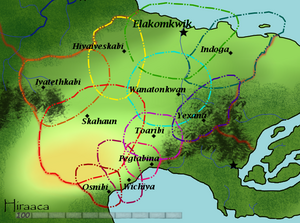Hiraaca
| Hiraaca | |
|---|---|
| Capital City: | |
| System of Governance: | |
| Leader(s) | |
| Primary Religion: | |
| Languages | |
| Majority Races | Predominantly Outlander, Canid |
| Strong Minorities | |
| Real World Influence: | |
Overview
Insulated from many of the rigors of world politics by the impenetrable jungles to the north and the intractable sea to the east, Hiraaca has long refused to adhere to the usual shape of kingdom or empire. Instead, the proud and adaptable Hiraacans live in a way very similar to their ancestors, ranging nomadically around their abundant grassland and woodland homes, spurning most theories of agriculture and depending on their bountiful surroundings instead.
The tribes of Hiraaca have longstanding relations with one another to try and reduce conflict or warfare, and when dealing with foreigners they readily understand the need to speak with a unified voice. For this purpose, one amongst all the clans is determined to be the foremost for purposes of dealing with outsiders and since 1995 that person has been Nota Ktehe of the Hiyaiyeskabi people. He is generally regarded as "King of Hiraaca" by outside visitors, though this has little bearing on the reality of his position.
Hiraaca is located on the southern shore of the Cyrnosian sea, south of Nzadi o Nzere and west of Lakamha. It also shares borders with Katagonia to the west and Chenooet to the southeast. The land is mostly a broad, flat prairie situated between two low mountain ranges, but includes an extremely arid desert in the southwest as well. The closest thing to a capital is a semi-permanent encampment of the Elakomkwik people located near the mouth of the Pekitanoui river, where outsiders are most likely to be found and where a great deal of trading and formal meetings occur.
Most of the population of Hiraaca are Outlanders, the free-wheeling horse-riding exuberant product of centuries of tradition and no interest in what others would term modernity. There is also a substantial Canid minority blended in amongst the clans, usually with no discernable status difference from the other folk of a tribe. There are also a scattering of Felinae amongst the people of Hiraaca, but again most identify first as part of their people rather than as a given race.
Hiraacans are fairly egalitarian with an elevated status associated mostly with age or excellence in specific well regarded skills including warfare, hunting, craftsmanship, or fieldcraft. Above this is a tier of spiritual leadership, the shamans of the clans, who help interpret moral decisions, seek guidance from the realm of spirits, and act as educators and healers. Practical leadership falls to respected elders.
Affairs of the world fly by without influencing much that goes on in Hiraaca, where the most significant change in a thousand years was the arrival of horses with Hispalian traders in the 1400s. The most important events of the last few decades would have to be a brief but decisive war between the Toaribi, Pegtabina, and Wichiya people on one side, and the Skahaun and Moanante on the other. The Moanante were dissolved and dispersed among other peoples by the end of the conflict in 2011, when accord was struck between the remaining combatants.
Culture
Culture found in land
Religions
what faiths are present, what are the views on faith
Social Structure
How the society is structured
Customs and Holidays
What days matter to the people
Arts and Exceptionalism
Politics
Government
Organization of the Land
How the power structure is divided regional (i.e. Duchies, Baronies, Lordships, etc.)
Demographics
Economy
Foreign Relations
History
History since the Dragon Wars
Early History
National History
Major Modern Events
What events will have shaped the experience of characters having grown up there
Geography
The physical lay of the land
